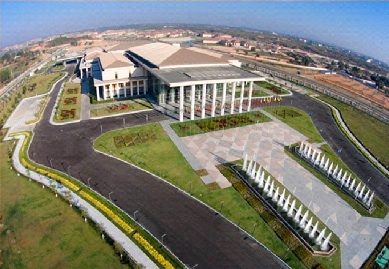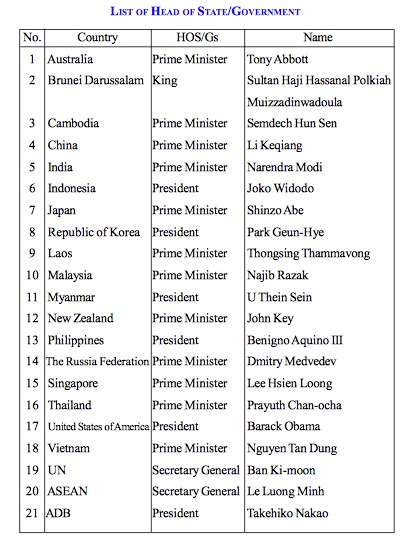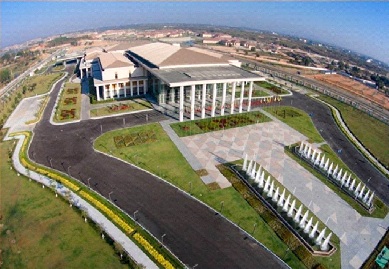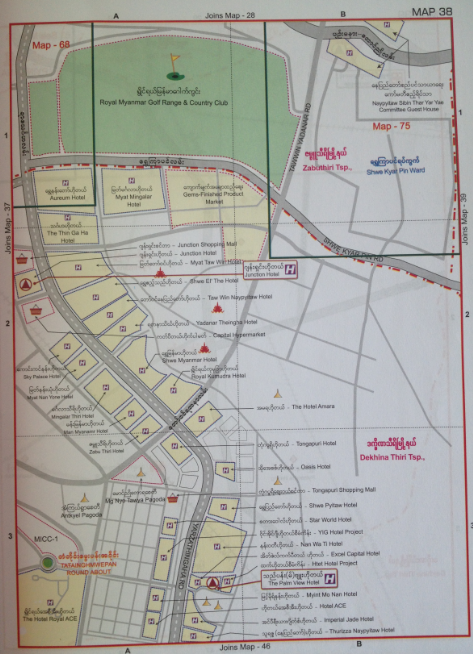This week the 25th ASEAN Summit descends on Myanmar’s capital, Naypyitaw. Chairing the Association of Southeast Asian Nations (ASEAN) this year, Myanmar has already host a plethora of regional meetings. This week is particularly significant–it is Myanmar’s grand finale until the chair rotates back to Myanmar in the next ten years or so. From 11 to 13 November 2014, heads of state from ASEAN’s ten-member states and ASEAN’s dialogue partners will take their seats around the tables at the Myanmar International Convention Centre-I.
Caption: Heads of State attending the East Asia Summit and ASEAN Summit 2014
Caption: Myanmar International Convention Centre-I
Caption: Myanmar International Convention Centre-I [see A3], Dekhina Thiri township, Naypyitaw.
Just nine years ago, Myanmar’s relationship with ASEAN was remarkably different from today. Back in the years when Myanmar’s domestic affairs showed no sign of improvement, Myanmar was under pressure from ASEAN members to relinquish its position to chair ASEAN for 2006. ASEAN’s reputation and credibility was being squeezed by the international community–the United States in particular–and so Myanmar was denied the chance to chair.
In January 2005, US Secretary of State Condoleezza Rice’s labeled Myanmar an ‘outpost of tyranny’. She also signalled her intention to skip the 2006 ASEAN Regional Forum meeting and threatened to suspend funds for development projects in Southeast Asia. In July 2005, Myanmar’s Foreign Minister U Nyan Win forfeited the chair, suggesting that Myanmar would be better off focusing on domestic affairs as laid out in the Roadmap to Democracy, which included building national reconciliation and working on processes of democratisation.
Chit Win, a scholar from the Australian National University, has highlighted how Myanmar’s policymakers have steered domestic issues away from ASEAN’s core agenda. Chit Win stresses the importance of understanding Myanmar’s long-term vision of becoming a regional powerhouse. With US President Barak Obama, UN Secretary General Ban-Ki Moon, Russian Prime Minister Dmitry Medvedev and Australian Prime Minister Tony Abbott in town, this week presents Myanmar with the opportunity to give its foreign policy ambitions a boost.
Such dignitaries will be warmly welcomed by the ASEAN symbols which fill Naypyitaw’s streetscape: national flags adorn lotus-flower roundabouts, and in Dekhina Thiri township–the hub of this week’s events–passers-by are reminded every three-hundred metres or so that they are being ‘warmly welcomed’ to Naypyitaw. While several road closures have been put in place, traffic police have been busy rehearsing their motorcade routes with ninety-nine BMW limousines–imported to serve ASEAN delegates for the week.
Right now the final preparations in Naypyitaw are underway: gardeners trim hotel lawns, shopping centres stock shelves, and restaurants fill fridges. Security in Napyitaw has stepped up several levels: roadblocks are in place, police guard the city’s entrance and inspect cars, hotel entrances are manned with police, and guards with binoculars conspicuously peer out from hotel rooves, looking over the landscape of hotels.
This week, New Mandala will bring you a range of insight into the 25th ASEAN Summit, and other exciting happenings around Naypyitaw. As always, we welcome submissions from anybody who has an informed contribution to add. Send us an email if you would like to make a post. If you have any special requests for New Mandala in Naypyitaw, post them on this comments page and we will do our best to inform you. We look forward to you joining New Mandala this week, for all things ASEAN!
Olivia Cable is a graduate student in the College of Asia and the Pacific, Australian National University. She is currently in Naypyitaw for the ASEAN Summit. Contact: [email protected] and Twitter @ojcable
 Facebook
Facebook  Twitter
Twitter  Soundcloud
Soundcloud  Youtube
Youtube  Rss
Rss 


